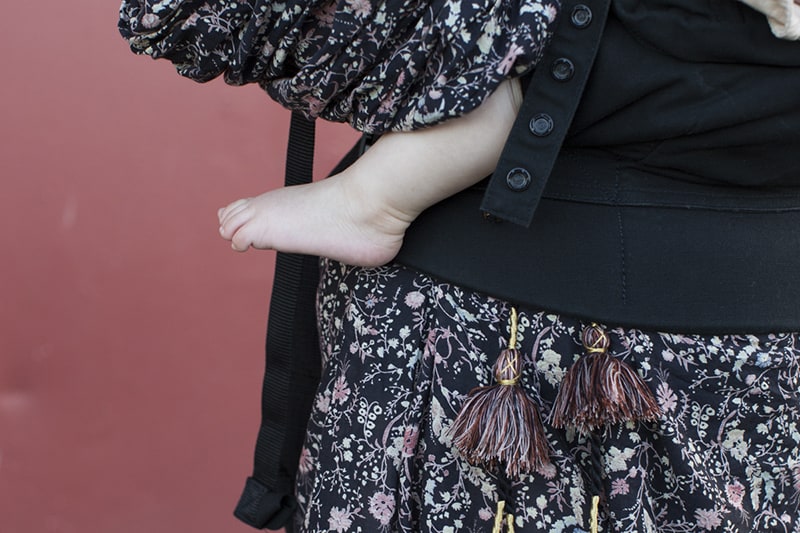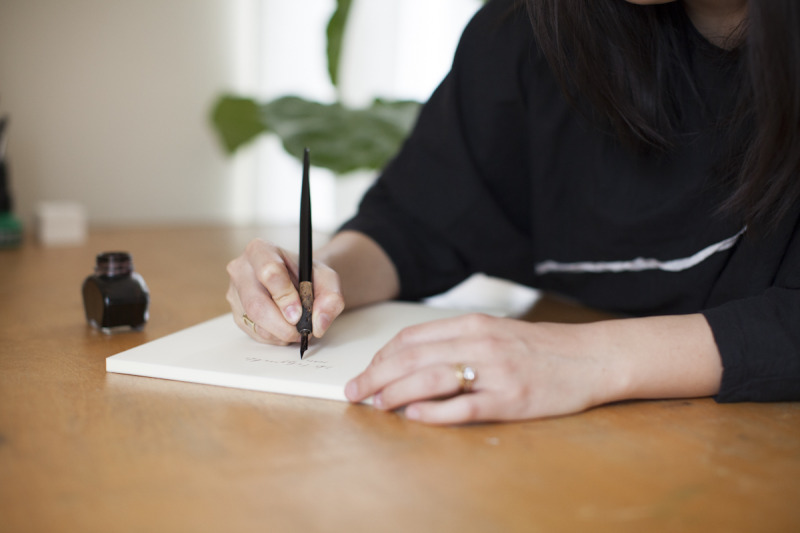
15 Tips for Flying with an Infant
Written by Sara Langer
Photography by Photographed by Michelle Drewes
With the holidays quickly approaching, the busiest time for travel is upon us. If you have a new baby and are planning to fly for the first time, naturally, you might be feeling a little anxious about your upcoming trip. The days of sipping a cocktail, diving into a book or magazine, or simply sticking your headphones in your ears when you hear the crying of a young passenger are now over (at least for a while). But it doesn’t need to be a scary or unpleasant experience, either. Infancy is actually a great time to travel, as your babe is not yet mobile (unless you have a very early walker), is on a liquid diet or eating very few solids, and is still taking frequent naps. Not to mention, traveling with a child under two years old means you don’t need to buy them a ticket, which makes flying less expensive now than it will be in a couple of years. That said, being prepared and having an idea of what to expect when flying with an infant will make it all the easier. While your hands will be full, quite literally, these tips are sure to help lighten your load and anxiety.
Book your ticket over the phone: Do some research online beforehand to get an idea of pricing, then call the airline to book your ticket. If you can afford to, buying a seat for your baby will assure you have plenty of space and a safe place to put the baby down. You can bring the carseat on the plane, which the FAA recommends as the safest way to fly with an infant. Many airlines even offer reduced fares for infants, but you can only get that rate if you book your flight over the phone. If you would rather keep the baby on your lap and save the money, let the agent on the phone know you will be traveling with a lap child and request a seat in the front of the plane. The front of the plane is not as noisy or turbulent as the rear and it will allow you to deplane sooner.
Allow extra time: The last thing you want is to be rushed getting to the airport and through security. If you’re stressed, the baby will pick up on that energy. Give yourself extra time to get to the airport as well as arriving at the airport earlier than you use to. You want to have time for unexpected diaper changes or feedings to keep your baby happy and comfortable.
Ditch the stroller and wear the baby: Unless your are traveling with more than one baby or child, or you have purchased a ticket for your baby and will be bringing the carseat on the plane, a stroller may be more trouble than it’s worth. Strollers can be cumbersome to move through crowds and if you have a layover with a tight connection, you may not have the time to wait for your stroller after deplaning. Wearing the baby while boarding and moving through the airport keeps your hands free for carrying everything else. You will be required to take the baby out of the carrier during take off and landing, but you can keep them on for the rest of the flight if they’re comfortable there. Even if you will need the stroller and carseat when you arrive, the airlines do not charge to check these items, so it won’t add to the cost of your travels.
Ask about occupancy: When you’re checking in at the airport, before checking your bags and going through security, ask the agent how full the flight is. If there are plenty of open seats on the plane they may be willing to give you an extra seat for your baby, or at least put you in a row with an unoccupied seat. If you are lucky enough to score a free seat, you may want to bring the carseat and stroller through security rather than checking them so the baby can sit in the carseat on the plane.
Prep before going through security and dress the part: Whether you’re using a stroller or wearing your baby, you will still have to carry them in your arms as you go through security, specifically while walking through the metal detectors. If you are traveling with breastmilk or any other liquids for baby, like pureed baby food or pre-made formula bottles, keep them in a separate bag, labeled with the contents so you can easily show it to TSA. If you’re wearing a jacket or bulky sweater, which you will be required to remove, take it off beforehand and stick it in one of your bags if you can. Wear shoes you can easily slip on and off without using your hands. Layers are good for both mom and baby, as the temperature on the plane can fluctuate.
Bring extra clothes for yourself: As the parent of an infant, you already know it’s a good idea to always have an extra set of clothes (or two) for the baby. Flying is not the time to dress them in the most precious and intricate outfits. Choose clothes that make diaper changes as easy as possible. Having an extra set of clothes for yourself is also a good idea in the case you get some unsavory bodily fluids on your duds. The last thing you want is to be sitting in soiled and smelly clothing for the duration of your trip. Leggings and a top that can pack down and won’t wrinkle easily will save space in your carry-on bags.
Buy diapers when you arrive: Of course you will need to have enough diapers (with extra for emergencies) to get you through your trip, but don’t fill your luggage with diapers. You’ll be able to purchase more when you arrive. If your baby can bear weight on their legs and is wearing at least a size 3 diaper, you can use slip-on diapers. Some airplane bathrooms do not have changing tables and the ones that do are comically small (most baby’s over 3-months-old won’t fit easily). Purchase the slip-on diapers before your trip so you can try them out at home and make sure they work for you.
Be thoughtful about your carry-on bags: Of course you want to be prepared with extra diapers, clothes, toys, and pacifiers, but don’t over do it. Overpacking will lead to heavy bags and make it much harder to find the items you need if you have to rummage through loads of stuff. We would recommend taking a backpack, which is easy to carry. Put the essentials in the outside pockets, including any of your personal items you need easy access to, like your ID and boarding pass. Pack the extra/emergency items on the bottom of the bag so they don’t get in the way when you’re pulling out the crucial items you will use more frequently. A bag with pockets and compartments is great, but if that’s not an option, separate items into plastic bags or zippered pouches to help things stay organized. Whether you go with a backpack, tote bag, or small rolling suitcase, make sure you can fit the essential items under your seat. You don’t want to deal with getting up and down and finding room in the highly coveted overhead bins.
Be strategic about your seats: If you are flying with another adult, you may want to consider choosing seats that are not together. This way the baby can go back and forth between the two of you. Not only will the other passengers in your row get a break if the baby is fussy, you get to have some alone time! Win win. If you’re flying on an airline without assigned seating, have one adult sit in the aisle and the other in the window seat, leaving the middle seat open. Most people will forgo choosing the middle seat, especially in a row with a baby, if there are other open seats on the plane.
Wait to board: Even though most airlines allow families with small children and babies to board early, you may want to wait until later in the boarding process. While getting on the plane early gives you extra time to get situated, it also means you have to sit on the plane that much longer with the baby. If you’re traveling with another adult, have them board first and take the bulk of the bags. Then you can hang out in the terminal until the end of the boarding process and simply slip into your seat with the baby without the struggle of carrying all of your bags. Even if you’re traveling solo with the baby, there will still be people behind you and rushing to board if you wait a bit. You’ll have plenty of time to get comfortable before take off.
Feed during take off and landing: The risk for discomfort in the baby’s ears is greatest as the pressure changes during take off and landing. The sucking motion and swallowing will help alleviate or bypass any possible discomfort. Offering the bottle or boob during the ascent and descent is a good distraction. Even if your baby only drinks breastmilk, having a bottle available may be a good idea if they are easily distracted during feedings and like to look around. If you are flying with another adult, a bottle will give them an opportunity to feed the baby as well. Ask the flight attendants to warm up the cold bottle, which shouldn’t be a problem. Having a pacifier as back up is also key.
Bring earplugs: Planes can be extremely noisy and, depending on where you’re sitting, it could act like a white noise machine or it may cause discomfort. Pack small earplugs or cotton balls for the baby, which may reduce the noise on the plane and make them more comfortable. If you wish, throw a few extras in your bags for the passengers around you, just in case you have an inconsolable baby. Hopefully they’ll appreciate your effort and understand that you don’t want the baby to cry even more than they do.
Be careful with the water: If you need water when you’re on the plane for formula, sippy cups, or rinsing a pacifier or bottles, make sure you do not use the water in the plane’s bathroom. The only thing that water should be used for is washing your hands. It’s not the same as tap water, so you should purchase water in the terminal or bring an empty water bottle to fill up before boarding. The flight attendants will also have bottled water on board that you should be able to use.
Don’t worry too much about the baby’s schedule: One popular piece of advice we’ve heard in regards to traveling to with an infant or toddler is to schedule your flight during nap time. But, if you’re a seasoned traveler (or even if you’re not), you know that delays and changes in your schedule happen far too often with air travel. Don’t be too stressed about sticking to your baby’s normal schedule or routine. You can certainly try and book a flight that will work within your routine and if there are no delays and everything goes smoothly, that’s great, but know that one day of traveling will not throw your set schedule out the door. Be flexible and know that your baby can adapt to changes in the short-term.
Believe in the kindness of strangers and don’t be afraid to ask for help: This is especially important to remember if you’re traveling alone. There could be an instance when you simply cannot hold the baby and do whatever else you are trying to do. You may be surprised how willing people are to help you, especially those that have been in your shoes before.
Try to relax and remember you’re one bad-ass mama: No matter how much you prepare beforehand, things may not go exactly as you hoped. Just remember, you will not be on that plane for the rest of your life and you will likely never see most of the other passengers again. Yes, traveling with an infant is no easy feat, but you’re presently taking on one of the toughest jobs out there. Motherhood is no walk in the park and you’ve already endured many of the challenges that come with being a new mom. Remember to be grateful you have the financial resources to travel, even if your trip doesn’t go as planned. You got this!
Write a Comment
Share this story





Such great tips..! we are heading away to NY next month with our baby. its his first flight so i need all of this information & the comfy that he can make it cross-country without us losing our minds. thanks for sharing